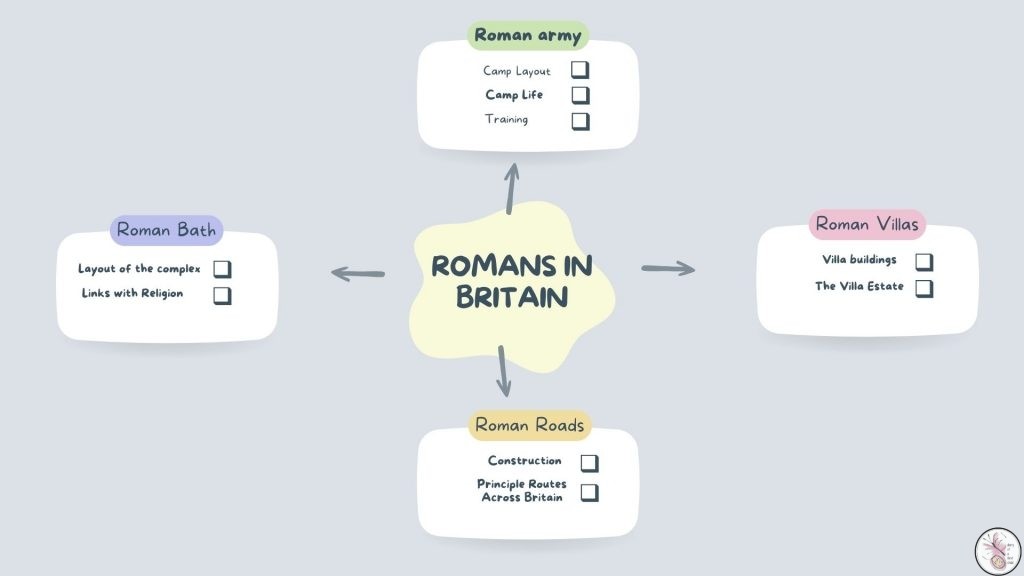We’ve undertaken to do the OCR GCSE (9-1) Latin exam this academic year, party because I did Latin at school and loved it, and partly because it gives students a fantastic foundation in many of the Romance Languages. It was a slightly tougher task than anticipated, though, as the resources provided are – at best – meagre. There are several books that can be bought but they all carry hefty price tags and as yet, I’m not entirely sure they’re the right ones! We’ve decided to compile all the information we’re learning into a good old-fashioned lapbook, which is currently a work in progress, and I’ve decided to do what I always do with this blog – use it as a place to record our learning, so this post is something of a weekly updated Wikipedia, being updated as we go along! I hope you find it useful as you embark on your journey, and if you have any additional resources that you think might help, please do add them in the comments below!
Villa Buildings
- The Cambridge Latin Course, Book 1 pg. 8 – 13 and 23 – 25 talks about the layout of the houses, the rooms, mosaics, décor and some furnishings. This seems to have come up in past exam papers. The cheapest we have found it is on World of Books (linked).
- While not directly related to the topic, we watched Insulae: How the masses lived (5:31) as it feels important to realise that not every Roman lived in splendour. In fact, 97% didn’t.
- A good overview here of Roman Villas in Britain (3:05) with the different layouts mentioned. Including, briefly, the ‘Winged-Corridor Villa’ – which is actually called Lullingstone Villa – from the prescribed sources booklet.
- Another really interesting video about Roman Villas (3:49) with extra bits of information not mentioned elsewhere. Narrated by a child, but well worth a watch.
- We used a picture from the Cambridge Latin Course, Book 1, also found online when searching for Roman Villas, as the cover image for our lapbook.
Villa Estates
The Villa Estates mentioned in the prescribed sources booklet are Lockleys Villa, Winged Corridor Villa (Lullingstone Villa) and North Leigh Villa. We have visited Brading Roman Villa and Newport Roman Villa on the Isle of Wight and both are highly recommended for really ‘placing’ the villa structure and lifestyle in mind. We printed most of these websites into something of a ‘folder’ of paper resources that we could discuss and determine their archaeological and historical importance.
- Assuming you can’t make it to a villa, here’s a walkthrough of Lullingstone Roman Villa (3:59). The visible remains of the villa include stone foundations and exquisite mosaic floors. Some of the earliest evidence of Christianity in Britain was found at this sight.
- A much longer, talkier video about Lullingstone (30:53), but really good background information from one of the Time Team people, Guy De La Bedoyere.
- Lockleys Villa doesn’t seem to feature much in video, but there are several website resources, such as Roman Britain and Wikipedia.
- North Leigh Roman Villa – information on its past and construction.
- Two interesting and different sites that illustrate life in Roman Britain over the second to fourth centuries as the buildings were developed and then abandoned in the fifth century.
- Archaeologists have rebuilt a Roman villa according to original specs in Somerset. If you can’t visit, there’s a pretty decent walk through here (3:37). Also includes outbuildings of a villa, including the wine press. The actual Newt in Somerset website has a fantastic half-hour video about making the murals and much more.
- We used the printable flashcards from Quizlet and I cut them out so that they could make ‘matching pairs’ – a slightly flawed version as the blocks were all different sizes, but it worked fairly well anyway! We then glued these into the lapbook using a zigzag template.
